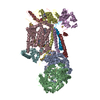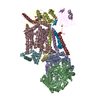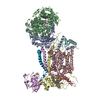[English] 日本語
 Yorodumi
Yorodumi- EMDB-21052: Human Drosha and DGCR8 in complex with Primary MicroRNA (MP/RNA c... -
+ Open data
Open data
- Basic information
Basic information
| Entry | Database: EMDB / ID: EMD-21052 | |||||||||||||||
|---|---|---|---|---|---|---|---|---|---|---|---|---|---|---|---|---|
| Title | Human Drosha and DGCR8 in complex with Primary MicroRNA (MP/RNA complex) - partially docked state | |||||||||||||||
 Map data Map data | Human Drosha and DGCR8 in complex with Primary MicroRNA (MP/RNA complex) - partially docked state | |||||||||||||||
 Sample Sample |
| |||||||||||||||
 Keywords Keywords |  Microprocessor / Microprocessor /  Drosha / DGCR8 / Primary MicroRNA / Drosha / DGCR8 / Primary MicroRNA /  RNA BINDING PROTEIN / RNA BINDING PROTEIN-RNA complex RNA BINDING PROTEIN / RNA BINDING PROTEIN-RNA complex | |||||||||||||||
| Function / homology |  Function and homology information Function and homology informationpositive regulation of pre-miRNA processing / protein-RNA adaptor activity / regulation of miRNA metabolic process /  primary miRNA binding / DEAD/H-box RNA helicase binding / regulation of regulatory T cell differentiation / Transcriptional Regulation by MECP2 / primary miRNA binding / DEAD/H-box RNA helicase binding / regulation of regulatory T cell differentiation / Transcriptional Regulation by MECP2 /  ribonuclease III / miRNA metabolic process / primary miRNA processing ...positive regulation of pre-miRNA processing / protein-RNA adaptor activity / regulation of miRNA metabolic process / ribonuclease III / miRNA metabolic process / primary miRNA processing ...positive regulation of pre-miRNA processing / protein-RNA adaptor activity / regulation of miRNA metabolic process /  primary miRNA binding / DEAD/H-box RNA helicase binding / regulation of regulatory T cell differentiation / Transcriptional Regulation by MECP2 / primary miRNA binding / DEAD/H-box RNA helicase binding / regulation of regulatory T cell differentiation / Transcriptional Regulation by MECP2 /  ribonuclease III / miRNA metabolic process / primary miRNA processing / regulation of stem cell proliferation / ribonuclease III / miRNA metabolic process / primary miRNA processing / regulation of stem cell proliferation /  microprocessor complex / pre-miRNA processing / microprocessor complex / pre-miRNA processing /  ribonuclease III activity / MicroRNA (miRNA) biogenesis / SMAD binding / ribonuclease III activity / MicroRNA (miRNA) biogenesis / SMAD binding /  R-SMAD binding / R-SMAD binding /  lipopolysaccharide binding / rRNA processing / lipopolysaccharide binding / rRNA processing /  double-stranded RNA binding / double-stranded RNA binding /  regulation of inflammatory response / defense response to Gram-negative bacterium / regulation of inflammatory response / defense response to Gram-negative bacterium /  postsynaptic density / postsynaptic density /  nuclear body / defense response to Gram-positive bacterium / glutamatergic synapse / nuclear body / defense response to Gram-positive bacterium / glutamatergic synapse /  heme binding / positive regulation of gene expression / heme binding / positive regulation of gene expression /  nucleolus / protein homodimerization activity / nucleolus / protein homodimerization activity /  RNA binding / RNA binding /  nucleoplasm / identical protein binding / nucleoplasm / identical protein binding /  metal ion binding / metal ion binding /  nucleus / nucleus /  cytosol / cytosol /  cytoplasm cytoplasmSimilarity search - Function | |||||||||||||||
| Biological species |   Homo sapiens (human) Homo sapiens (human) | |||||||||||||||
| Method |  single particle reconstruction / single particle reconstruction /  cryo EM / Resolution: 4.4 Å cryo EM / Resolution: 4.4 Å | |||||||||||||||
 Authors Authors | Partin A / Zhang K | |||||||||||||||
| Funding support |  United States, 4 items United States, 4 items
| |||||||||||||||
 Citation Citation |  Journal: Mol Cell / Year: 2020 Journal: Mol Cell / Year: 2020Title: Cryo-EM Structures of Human Drosha and DGCR8 in Complex with Primary MicroRNA. Authors: Alexander C Partin / Kaiming Zhang / Byung-Cheon Jeong / Emily Herrell / Shanshan Li / Wah Chiu / Yunsun Nam /  Abstract: Metazoan microRNAs require specific maturation steps initiated by Microprocessor, comprising Drosha and DGCR8. Lack of structural information for the assembled complex has hindered an understanding ...Metazoan microRNAs require specific maturation steps initiated by Microprocessor, comprising Drosha and DGCR8. Lack of structural information for the assembled complex has hindered an understanding of how Microprocessor recognizes primary microRNA transcripts (pri-miRNAs). Here we present a cryoelectron microscopy structure of human Microprocessor with a pri-miRNA docked in the active site, poised for cleavage. The basal junction is recognized by a four-way intramolecular junction in Drosha, triggered by the Belt and Wedge regions that clamp over the ssRNA. The belt is important for efficiency and accuracy of pri-miRNA processing. Two dsRBDs form a molecular ruler to measure the stem length between the two dsRNA-ssRNA junctions. The specific organization of the dsRBDs near the apical junction is independent of Drosha core domains, as observed in a second structure in the partially docked state. Collectively, we derive a molecular model to explain how Microprocessor recognizes a pri-miRNA and accurately identifies the cleavage site. | |||||||||||||||
| History |
|
- Structure visualization
Structure visualization
| Movie |
 Movie viewer Movie viewer |
|---|---|
| Structure viewer | EM map:  SurfView SurfView Molmil Molmil Jmol/JSmol Jmol/JSmol |
| Supplemental images |
- Downloads & links
Downloads & links
-EMDB archive
| Map data |  emd_21052.map.gz emd_21052.map.gz | 59.3 MB |  EMDB map data format EMDB map data format | |
|---|---|---|---|---|
| Header (meta data) |  emd-21052-v30.xml emd-21052-v30.xml emd-21052.xml emd-21052.xml | 17.1 KB 17.1 KB | Display Display |  EMDB header EMDB header |
| Images |  emd_21052.png emd_21052.png | 163.4 KB | ||
| Filedesc metadata |  emd-21052.cif.gz emd-21052.cif.gz | 6.9 KB | ||
| Archive directory |  http://ftp.pdbj.org/pub/emdb/structures/EMD-21052 http://ftp.pdbj.org/pub/emdb/structures/EMD-21052 ftp://ftp.pdbj.org/pub/emdb/structures/EMD-21052 ftp://ftp.pdbj.org/pub/emdb/structures/EMD-21052 | HTTPS FTP |
-Related structure data
| Related structure data |  6v5cMC  6v5bC C: citing same article ( M: atomic model generated by this map |
|---|---|
| Similar structure data |
- Links
Links
| EMDB pages |  EMDB (EBI/PDBe) / EMDB (EBI/PDBe) /  EMDataResource EMDataResource |
|---|---|
| Related items in Molecule of the Month |
- Map
Map
| File |  Download / File: emd_21052.map.gz / Format: CCP4 / Size: 64 MB / Type: IMAGE STORED AS FLOATING POINT NUMBER (4 BYTES) Download / File: emd_21052.map.gz / Format: CCP4 / Size: 64 MB / Type: IMAGE STORED AS FLOATING POINT NUMBER (4 BYTES) | ||||||||||||||||||||||||||||||||||||||||||||||||||||||||||||
|---|---|---|---|---|---|---|---|---|---|---|---|---|---|---|---|---|---|---|---|---|---|---|---|---|---|---|---|---|---|---|---|---|---|---|---|---|---|---|---|---|---|---|---|---|---|---|---|---|---|---|---|---|---|---|---|---|---|---|---|---|---|
| Annotation | Human Drosha and DGCR8 in complex with Primary MicroRNA (MP/RNA complex) - partially docked state | ||||||||||||||||||||||||||||||||||||||||||||||||||||||||||||
| Voxel size | X=Y=Z: 1.06 Å | ||||||||||||||||||||||||||||||||||||||||||||||||||||||||||||
| Density |
| ||||||||||||||||||||||||||||||||||||||||||||||||||||||||||||
| Symmetry | Space group: 1 | ||||||||||||||||||||||||||||||||||||||||||||||||||||||||||||
| Details | EMDB XML:
CCP4 map header:
| ||||||||||||||||||||||||||||||||||||||||||||||||||||||||||||
-Supplemental data
- Sample components
Sample components
-Entire : Human Drosha and DGCR8 in complex with Primary MicroRNA (MP/RNA c...
| Entire | Name: Human Drosha and DGCR8 in complex with Primary MicroRNA (MP/RNA complex) - partially docked state |
|---|---|
| Components |
|
-Supramolecule #1: Human Drosha and DGCR8 in complex with Primary MicroRNA (MP/RNA c...
| Supramolecule | Name: Human Drosha and DGCR8 in complex with Primary MicroRNA (MP/RNA complex) - partially docked state type: complex / ID: 1 / Parent: 0 / Macromolecule list: all |
|---|---|
| Source (natural) | Organism:   Homo sapiens (human) Homo sapiens (human) |
| Molecular weight | Theoretical: 40 KDa |
-Macromolecule #1: Ribonuclease 3
| Macromolecule | Name: Ribonuclease 3 / type: protein_or_peptide / ID: 1 / Number of copies: 1 / Enantiomer: LEVO / EC number:  ribonuclease III ribonuclease III |
|---|---|
| Source (natural) | Organism:   Homo sapiens (human) Homo sapiens (human) |
| Molecular weight | Theoretical: 118.377742 KDa |
| Recombinant expression | Organism:   Baculovirus expression vector pFastBac1-HM Baculovirus expression vector pFastBac1-HM |
| Sequence | String: GSGHRSPSRE KKRARWEEEK DRWSDNQSSG KDKNYTSIKE KEPEETMPDK NEEEEEELLK PVWIRCTHSE NYYSSDPMDQ VGDSTVVGT SRLRDLYDKF EEELGSRQEK AKAARPPWEP PKTKLDEDLE SSSESECESD EDSTCSSSSD SEVFDVIAEI K RKKAHPDR ...String: GSGHRSPSRE KKRARWEEEK DRWSDNQSSG KDKNYTSIKE KEPEETMPDK NEEEEEELLK PVWIRCTHSE NYYSSDPMDQ VGDSTVVGT SRLRDLYDKF EEELGSRQEK AKAARPPWEP PKTKLDEDLE SSSESECESD EDSTCSSSSD SEVFDVIAEI K RKKAHPDR LHDELWYNDP GQMNDGPLCK CSAKARRTGI RHSIYPGEEA IKPCRPMTNN AGRLFHYRIT VSPPTNFLTD RP TVIEYDD HEYIFEGFSM FAHAPLTNIP LCKVIRFNID YTIHFIEEMM PENFCVKGLE LFSLFLFRDI LELYDWNLKG PLF EDSPPC CPRFHFMPRF VRFLPDGGKE VLSMHQILLY LLRCSKALVP EEEIANMLQW EELEWQKYAE ECKGMIVTNP GTKP SSVRI DQLDREQFNP DVITFPIIVH FGIRPAQLSY AGDPQYQKLW KSYVKLRHLL ANSPKVKQTD KQKLAQREEA LQKIR QKNT MRREVTVELS SQGFWKTGIR SDVCQHAMML PVLTHHIRYH QCLMHLDKLI GYTFQDRCLL QLAMTHPSHH LNFGMN PDH ARNSLSNCGI RQPKYGDRKV HHMHMRKKGI NTLINIMSRL GQDDPTPSRI NHNERLEFLG DAVVEFLTSV HLYYLFP SL EEGGLATYRT AIVQNQHLAM LAKKLELDRF MLYAHGPDLC RESDLRHAMA NCFQALIGAV YLEGSLEEAK QLFGRLLF N DPDLREVWLN YPLHPLQLQE PNTDRQLIET SPVLQKLTEF EEAIGVIFTH VRLLARAFTL RTVGFNHLTL GHNQRMEFL GDSIMQLVAT EYLFIHFPDH HEGHLTLLRS SLVNNRTQAK VAEELGMQEY AITNDKTKRP VALRTKTLAD LLQSFIAALY IDKDLEYVH TFMNVCFFPR LKEFILNQDW NDPKSQLQQC CLTLRTEGKE PDIPLYKTLQ TVGPSHARTY TVAVYFKGER I GCGKGPSI QQAEMGAAMD ALEKYNFPQM AHQKRFIERK YRQELKEMRW EREHQERE UniProtKB:  Ribonuclease 3 Ribonuclease 3 |
-Macromolecule #2: Microprocessor complex subunit DGCR8
| Macromolecule | Name: Microprocessor complex subunit DGCR8 / type: protein_or_peptide / ID: 2 / Number of copies: 2 / Enantiomer: LEVO |
|---|---|
| Source (natural) | Organism:   Homo sapiens (human) Homo sapiens (human) |
| Molecular weight | Theoretical: 60.550602 KDa |
| Recombinant expression | Organism:   Escherichia coli 'BL21-Gold(DE3)pLysS AG' (bacteria) Escherichia coli 'BL21-Gold(DE3)pLysS AG' (bacteria) |
| Sequence | String: GSGAIVQRDR VDEEALNFPY EDDFDNDVDA LLEEGLCAPK KRRTEEKYGG DSDHPSDGET SVQPMMTKIK TVLKSRGRPP TEPLPDGWI MTFHNSGVPV YLHRESRVVT WSRPYFLGTG SIRKHDPPLS SIPCLHYKKM KDNEEREQSS DLTPSGDVSP V KPLSRSAE ...String: GSGAIVQRDR VDEEALNFPY EDDFDNDVDA LLEEGLCAPK KRRTEEKYGG DSDHPSDGET SVQPMMTKIK TVLKSRGRPP TEPLPDGWI MTFHNSGVPV YLHRESRVVT WSRPYFLGTG SIRKHDPPLS SIPCLHYKKM KDNEEREQSS DLTPSGDVSP V KPLSRSAE LEFPLDEPDS MGADPGPPDE KDPLGAEAAP GALGQVKAKV EVCKDESVDL EEFRSYLEKR FDFEQVTVKK FR TWAERRQ FNREMKRKQA ESERPILPAN QKLITLSVQD APTKKEFVIN PNGKSEVCIL HEYMQRVLKV RPVYNFFECE NPS EPFGAS VTIDGVTYGS GTASSKKLAK NKAARATLEI LIPDFVKQTS EEKPKDSEEL EYFNHISIED SRVYELTSKA GLLS PYQIL HECLKRNHGM GDTSIKFEVV PGKNQKSEYV MACGKHTVRG WCKNKRVGKQ LASQKILQLL HPHVKNWGSL LRMYG RESS KMVKQETSDK SVIELQQYAK KNKPNLHILS KLQEEMKRLA EEREETRK UniProtKB:  Microprocessor complex subunit DGCR8 Microprocessor complex subunit DGCR8 |
-Macromolecule #3: Pri-miR-16-2 (66-MER)
| Macromolecule | Name: Pri-miR-16-2 (66-MER) / type: rna / ID: 3 / Number of copies: 1 |
|---|---|
| Source (natural) | Organism:   Homo sapiens (human) Homo sapiens (human) |
| Molecular weight | Theoretical: 33.646934 KDa |
| Sequence | String: CUGACAUACU UGUUCCACUC UAGCAGCACG UAAAUAUUGG CGUAGUGAAA UAUAUAUUAA ACACCAAUAU UACUGUGCUG CUUUAGUGU GACAGGGAUA CAGCAA GENBANK:  GENBANK: AC024221.23 GENBANK: AC024221.23 |
-Experimental details
-Structure determination
| Method |  cryo EM cryo EM |
|---|---|
 Processing Processing |  single particle reconstruction single particle reconstruction |
| Aggregation state | particle |
- Sample preparation
Sample preparation
| Concentration | 3.7 mg/mL |
|---|---|
| Buffer | pH: 7.1 |
| Vitrification | Cryogen name: ETHANE / Chamber humidity: 100 % / Instrument: FEI VITROBOT MARK IV |
| Details | Human Drosha and DGCR8 in complex with Primary MicroRNA (MP/RNA complex) - partially docked state |
- Electron microscopy
Electron microscopy
| Microscope | FEI TITAN KRIOS |
|---|---|
| Electron beam | Acceleration voltage: 300 kV / Electron source:  FIELD EMISSION GUN FIELD EMISSION GUN |
| Electron optics | C2 aperture diameter: 70.0 µm / Illumination mode: FLOOD BEAM / Imaging mode: BRIGHT FIELD Bright-field microscopy / Cs: 2.7 mm / Nominal defocus max: 3.6 µm / Nominal defocus min: 1.5 µm / Nominal magnification: 130000 Bright-field microscopy / Cs: 2.7 mm / Nominal defocus max: 3.6 µm / Nominal defocus min: 1.5 µm / Nominal magnification: 130000 |
| Specialist optics | Energy filter - Name: GIF Quantum LS / Energy filter - Slit width: 20 eV |
| Sample stage | Specimen holder model: FEI TITAN KRIOS AUTOGRID HOLDER / Cooling holder cryogen: NITROGEN |
| Image recording | Film or detector model: GATAN K2 SUMMIT (4k x 4k) / Detector mode: COUNTING / Digitization - Frames/image: 1-30 / Number grids imaged: 4 / Number real images: 6070 / Average exposure time: 6.0 sec. / Average electron dose: 46.8 e/Å2 |
| Experimental equipment |  Model: Titan Krios / Image courtesy: FEI Company |
- Image processing
Image processing
| Particle selection | Number selected: 1063710 |
|---|---|
| Startup model | Type of model: OTHER |
| Initial angle assignment | Type: MAXIMUM LIKELIHOOD / Software - Name: RELION (ver. 3.0.2) |
| Final 3D classification | Number classes: 3 / Software - Name: RELION (ver. 3.0.2) |
| Final angle assignment | Type: MAXIMUM LIKELIHOOD / Software - Name: RELION (ver. 3.0.2) |
| Final reconstruction | Applied symmetry - Point group: C1 (asymmetric) / Resolution.type: BY AUTHOR / Resolution: 4.4 Å / Resolution method: FSC 0.143 CUT-OFF / Software - Name: cryoSPARC (ver. 2.0.5) / Number images used: 381468 |
-Atomic model buiding 1
| Refinement | Space: REAL / Protocol: BACKBONE TRACE |
|---|---|
| Output model |  PDB-6v5c: |
 Movie
Movie Controller
Controller

















